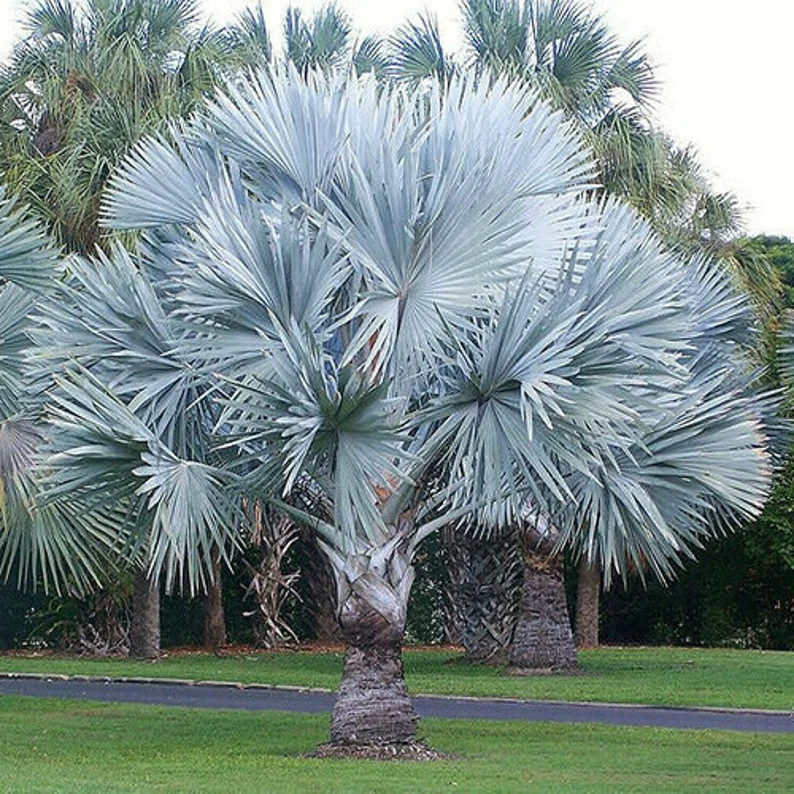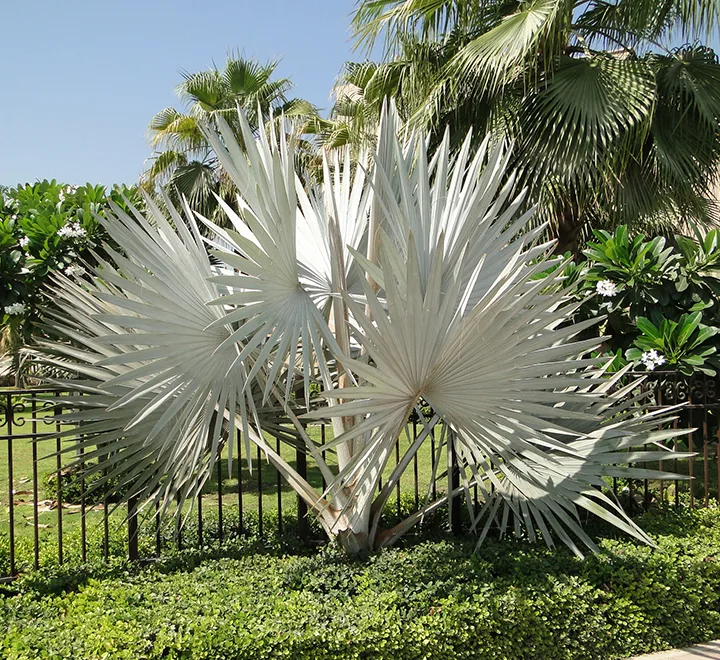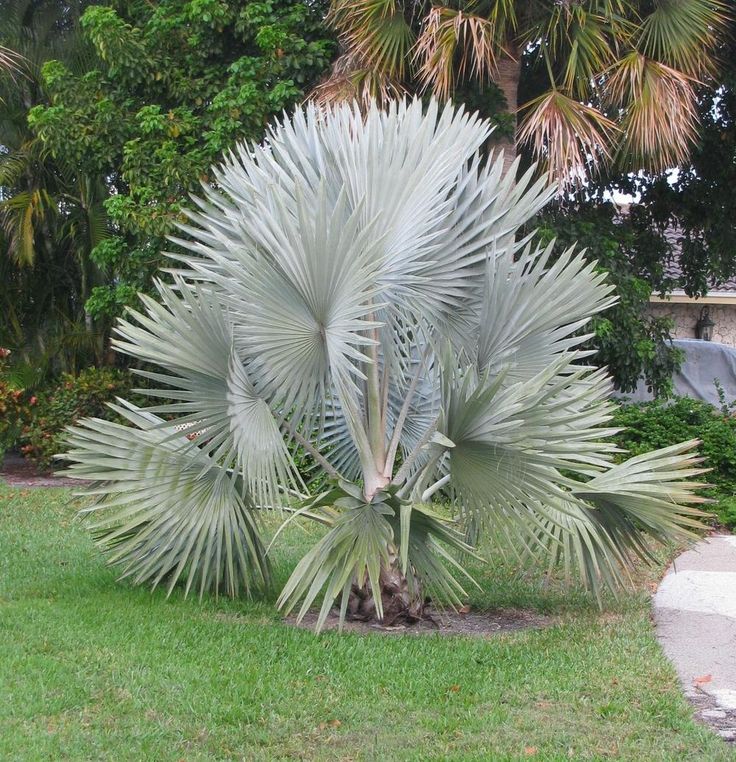table of contents
Introduction
The Blue Palm (Bismarckia nobilis), originally from Madagascar, is a true botanical gem that captivates plant lovers all over the world. With its fan-shaped silver leaves, this palm tree impresses with its magnificence and elegance. Its sturdy trunk and pronounced silver-blue leaves give it a lush look, making it a popular choice for landscaping in tropical and subtropical regions. The Blue Palm not only adds a touch of sophistication to gardens and parks, but is also hardy and adaptable, making it a versatile choice for outdoor environments.
Meaning of the Blue Palm
In addition to its stunning beauty, the Blue Palm is often associated with symbolic meanings. Its majestic presence symbolizes nobility and grandeur, adding a touch of royalty to any landscape. As a representative of Madagascar’s biodiversity, Bismarckia nobilis also highlights the importance of conserving and preserving this African country ‘s unique flora. By cultivating the Blue Palm, we not only add elegance to the environment, but also contribute to the celebration and preservation of global botanical diversity.
| Common Name | Blue Palm |
| Botanical Name | Bismarckia nobilis |
| Family | Arecaceae |
| Plant Type | Palm |
| Adult Size | Reaches up to 25 meters in height |
| Sun exposure | Full sun |
| Soil type | Well-drained, sandy, clayey |
| soil pH | Slightly acidic to alkaline (6.0 – 7.5) |
| Flowering time | Sporadic inflorescences throughout the year |
| Flower color | Flowers not significant in relation to its majestic size |
| Native Area | Madagascar |
| Toxicity | Not known to be toxic |

How to Care for the Blue Palm
Light
To ensure the lush flowering of the Blue Palm, it is essential to provide adequate sun exposure. This tropical palm thrives in full sun, so make sure you position the plant in a spot that receives direct sunlight.
Soil
The type of soil plays a crucial role in growing Bismarckia nobilis. Opt for well-drained soil , preferably sandy or loamy. Ensure that the mixture allows water to drain easily, preventing it from accumulating in the substrate.
Water
Proper water management is essential for the health of the Blue Palm. Maintain a regular watering regime, allowing the soil to dry out superficially between waterings. Avoid waterlogging, as this can lead to root problems.
Temperature and humidity
The Blue Palm thrives in hot climates, so it’s important to maintain a constant temperature around it. Avoid exposure to cold drafts, providing a tropical environment for its development. Maintain adequate humidity levels to replicate native conditions.
Fertilizing
Fertilize the Blue Palm regularly during the growing season. Choose a balanced fertilizer for palm trees and follow the application instructions. Proper fertilization will provide the nutrients needed for lush growth and healthy foliage.
By following these care guidelines, you’ll be fostering an environment conducive to the Blue Palm flourishing, showing off all its tropical splendor.

How to make Blue Palm Cuttings
Propagating the Blue Palm can be a rewarding experience to expand your collection of exotic plants. Follow these steps to make successful cuttings:
- Choosing Healthy Seedlings:
- Select vigorous, healthy shoots for propagation.
- Make sure that the seedlings you choose show no signs of disease or damage.
- Precise cutting:
- Use a sharp tool to make clean cuts on the seedlings.
- Cut close to the main stem, ensuring that the seedling contains a healthy piece of stem.
- Preparing the substrate:
- Use a suitable substrate, such as a nutrient-rich soil mix.
- Ensure good drainage to avoid water accumulating around the seedlings.
- Planting the seedlings:
- Plant the cuttings in the prepared substrate, pressing gently to secure them.
- Keep the soil slightly moist during the rooting period.
- Suitable environment:
- Place the cuttings in a location with filtered light, avoiding direct exposure to the sun.
- Maintain a moderate level of humidity around the cuttings to promote rooting.
How to plant the Blue Palm
When planting the Blue Palm, it is crucial to follow a few guidelines to ensure a healthy establishment:
- Site selection:
- Select a location that receives direct sunlight but is protected from strong winds.
- Consider the space needed for vertical growth and the width of the leaves.
- Soil preparation:
- Use a well-drained soil, mixing sand or perlite to promote drainage.
- Make sure the soil is rich in nutrients.
- Planting the Blue Palm:
- Plant the seedling or established palm tree in the center of the prepared hole.
- Firm the soil around the roots and water well.
- Initial care:
- Monitor the soil moisture and water as necessary in the first few months.
- Protect the plant from strong winds until it is established.
By following these guidelines, you will be providing the ideal conditions for the healthy growth of the Blue Palm in your garden or landscape.

Most common pests and diseases
When growing the Blue Palm, it is essential to be aware of the possible pests and diseases that can affect the plant’s health. Here is a list of the most common ones:
- Mealybugs:
- Symptoms: White or padded spots on the leaves.
- Solution: Remove by hand or use natural insecticides.
- Mites:
- Symptoms: Fine webs and yellowing of the leaves.
- Solution: Use pressurized water to kill the mites or apply neem oil.
- Fungus:
- Symptoms: Leaf spots and wilting.
- Solution: Treat with appropriate fungicides and avoid excess humidity.
- Stem canker:
- Symptoms: Lesions on the leaves and trunk.
- Solution: Remove the affected parts and apply a wound sealant.
Common problems and their solutions
In addition to specific pests, some common problems can arise when growing Blue Palm. Here are some common situations and their solutions:
- Yellow leaves:
- Cause: Lack of nutrients or excessive watering.
- Solution: Fertilize the plant with a balanced fertilizer and adjust the watering regime.
- Leaf spots:
- Cause: Excessive humidity or fungal attack.
- Solution: Improve soil drainage and treat with fungicides if necessary.
- Slow growth:
- Cause: Insufficient nutrients in the soil.
- Solution: Fertilize regularly with balanced fertilizer.
By closely monitoring your Blue Palm and taking preventative measures, you will be strengthening its defenses against pests and diseases, ensuring a healthy and vibrant crop.
Curiosities and myths
Explore the fascinating world of the Blue Palm (Bismarckia nobilis), a species that goes beyond its exuberant beauty. Discover intriguing curiosities and unravel myths associated with this majestic palm.
Curiosities about the Blue Palm
- Wide-spreading leaves:
- The leaves of the Blue Palm can reach up to 3 meters in length, giving it an imposing and unique presence in landscaping.
- Resistance to extreme conditions:
- Originally from Madagascar, Bismarckia nobilis is known for its resistance to adverse climatic conditions, from intense heat to dry soils.
- Impressive longevity:
- This palm tree can live for more than 80 years, providing decades of beauty and majestic presence in its environment.
Myths surrounding the Blue Palm
- Difficult to maintain:
- Myth: Despite its imposing appearance, the Blue Palm is hardy and adaptable, requiring basic care and being suitable for a variety of climates.
- Excessive Growth:
- Myth: Although its leaves are large, the Blue Palm is suitable for gardens of different sizes and can be adapted to the space available.
- Need for Specific Soil:
- Myth: This palm thrives in well-drained soil, but is adaptable to different types of soil, as long as the drainage is adequate.
Find out more about the Blue Palm, debunk misconceptions and enjoy the uniqueness of this magnificent species.

Conclusion
As we explore the various aspects of the Blue Palm (Bismarckia nobilis), from its origin in Madagascar to its impressive characteristics, it is clear that this species goes beyond a simple ornamental plant. Its imposing presence, lush leaves and resistance to adverse conditions make it a captivating choice for gardening enthusiasts the world over. The Blue Palm’s imposing longevity, which can exceed eight decades, highlights not only its beauty, but also its ability to take root as a silent witness to time.
By debunking misconceptions and highlighting its unique characteristics, we conclude that the Blue Palm is not just a plant, but a masterpiece of nature. Its cultivation not only adds elegance to gardens and landscapes, but also carries with it the history and exuberance of Madagascar. By choosing to integrate the Blue Palm into our green spaces, we not only beautify our lives, but also connect with a botanical legacy that transcends borders and endures over time. Growing this magnificent palm tree is an invitation to witness the enduring elegance of nature in its most imposing form.
Frequently Asked Questions
How big is the blue palm?
The Blue Palm (Bismarckia nobilis) can reach impressive heights of up to 25 meters, with its fan leaves reaching a remarkable wingspan. Its majestic size makes it an outstanding choice for landscaping, especially in tropical and subtropical regions.
How much does the blue palm grow each year?
The annual growth rate of the Blue Palm varies, but is generally moderate. Under ideal conditions, it can grow between 30 and 60 centimeters per year. This constant rhythm, combined with its longevity, contributes to the formation of an imposing plant over time.
Can you eat the fruit of the blue palm?
As for eating the fruit, it’s important to note that the Blue Palm is not grown primarily for its fruit. Furthermore, the fruit is known to be inedible and does not represent a significant food source. Its popularity lies mainly in the aesthetics of its leaves and its elegant size, and it is appreciated more for these characteristics than for its fruit.







